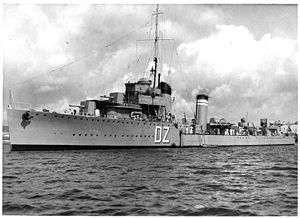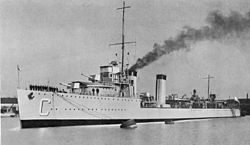Churruca-class destroyer (1927)
 Destroyer José Luis Diez
| |
| Class overview | |
|---|---|
| Name | Churruca class |
| Builders | SECN, Naval Dockyard, Cartagena. |
| Operators | |
| Preceded by | Template:Sclass- |
| Succeeded by | Template:Sclass- |
| Built | 1923–1951 |
| In commission | 1927–1982 |
| Completed | 18 |
| Lost | 2 |
| Retired | 16 |
| General characteristics | |
| Type | Destroyer |
| Displacement | 1,536 – 1,650 tons (normal); 2,067 tons (maximum) |
| Length | 101.00 m (331.36 ft) |
| Height | 3.30 m (10.8 ft) |
| Draught | 3.30 m (10.8 ft) |
| Installed power |
|
| Propulsion | 2 Parsons turbines |
| Speed | 36 knots (67 km/h) |
| Range |
|
| Complement | 160 |
| Armament |
|
| Notes | 240 tons oil fuel |
The Churruca class was a Spanish destroyer class built for the Spanish Navy based on a British design. Eighteen ships were built, with two being sold to Argentina.
The ships were authorized on 17 February 1915 by Navy Minister Augusto Miranda y Godoy. The program planned for four light cruisers, six destroyers, 28 submarines, three gunboats, and 18 coast guard vessels; of these, five light cruisers, three Template:Sclass- and fourteen Churruca-class destroyers, 16 submarines, and the three gunboats were actually completed.
Some of the later ships of the class were completed without the central gun due to an arms embargo during the Spanish Civil War.
History
The three first ships (Churruca, Alcalá Galiano, and Sánchez Barcáiztegui) were launched between May 1925 and June 1926. When Plus Ultra went to Argentina, she was accompanied by Méndez Núñez and Alsedo. These vessels arrived in Buenos Aires on 7 February 1926. The Argentine Navy was interested in purchasing Alsedo, and the Spanish government on 25 May 1927 provided credit to buy ships in Spain. Argentina eventually purchased Churruca and Alcalá Galiano, renaming them Cervantes and Juan de Garay.
Between 1928 and 1933, Churruca and Alcalá Galiano were launched, along with four other vessels, followed by seven more between 1935 and 1937.
Spanish Civil War
At the start of the Spanish Civil War, the class served on the Spanish Republican Navy and blockaded the Gibraltar Strait. Class members saw some action. Almirante Ferrándiz and Gravina took part in the Battle of Cape Espartel, where Almirante Ferrándiz was sunk by the Nationalist cruiser Canarias. Lepanto, Almirante Valdes, Almirante Antequera, Gravina, Jorge Juan, and Escaño participated in the Battle of Cape Cherchell. Lepanto, Sánchez Barcaiztegui, Almirante Miranda and Grafina were engaged in the Battle of Cape Palos, where Lepanto sank the Nationalist cruiser Baleares with torpedoes. Ciscar was sunk by aircraft in Gijon harbour, refloated by the rebels, and used by them in the final phases of the war.
One member of the class, due to her strong resemblance to a British destroyer, was used in an attempt to break the blockade of the Gibraltar Strait and return to the Mediterranean Sea after the fall of the Republican government in the north of Spain in 1938. José Luis Díez, painted with the pennant number of HMS Grenville, was intercepted by Canarias and other ships, and beached herself in Gibraltar.
Post-war service
When the Spanish Civil War ended, the class was turned over to the Nationalists.
The last two ships were commissioned in 1951, updated with only 4 guns but quadruple rather than triple torpedo tubes, Q gun being landed as weight compensation.
Argentinian Navy Service

Churruca and Alcalá Galiano were sold to the Argentine Navy while under construction. They were renamed ARA Cervantes (E1) and ARA Juan de Garay (named after Juan de Garay) respectively. The ships were commissioned on 3 September 1927 and modernised after World War II. The modernisation involved removing the midships 120 mm gun and the 76 mm gun and replacing these weapons with six 40 mm (1.6 in) Bofors guns .[1] These were Swedish built weapons in hand-worked twin mountings with air-cooled barrels and locally controlled, not the more familiar director-controlled, water-cooled and power operated mountings popularized by the U.S. Navy, British Royal Navy and others. The Bofors guns were placed in pairs; two between the funnels and one aft of the second funnel. In 1952, the two vessels were reclassified as destroyer escorts (torpederos).[1]
Cervantes was severely damaged by Gloster Meteor fighters loyal to Juan Domingo Perón while evacuating personnel from the rebel naval base of Rio Santiago during the 1955 Revolución Libertadora. She was placed in reserve in May 1961. Juan de Garay was used as a training vessel from 1952–59.[1]
Ships in class
|
Name |
Launched |
Decommissioned |
Fate |
Notes |
|---|---|---|---|---|
| 1925 | 1927 | Sold | to Argentina, renamed ARA Cervantes. Decommissioned 1961 | |
| 1927 | 1927 | Sold | to Argentina, renamed ARA Juan de Garay. Decommissioned 1960 | |
| 1928 | 1964 | Obsolete | Scrapped | |
| 1929 | 1965 | Obsolete | Scrapped | |
| 1929 | 1936 | Sunk | In action, by the cruiser Canarias | |
| 1930 | 1957 | Obsolete | Scrapped | |
| 1931 | 1957 | Obsolete | Scrapped | |
| 1931 | 1963 | Obsolete | Scrapped | |
| 1933 | 1957 | Obsolete | Scrapped | |
| 1935 | 1965 | Obsolete | Scrapped | |
| 1936 | 1970 | Obsolete | Scrapped | |
| 1936 | 1957 | Ran aground | ||
| 1936 | 1963 | Obsolete | Scrapped | |
| 1936 | 1963 | Obsolete | Scrapped | |
|
Jorge Juan |
1937 | 1959 | Obsolete | Scrapped |
| 1937 | 1963 | Obsolete | Scrapped | |
| 1946 | 1982 | Obsolete | Scrapped | |
| 1947 | 1978 | Obsolete | Scrapped |
References
Citations
References
- Flórez, Dionisio García. Buques de la Guerra Civil Española. Destructores (in Spanish). ISBN 84-932284-7-8.
- Gardiner, Robert; Chumbley, Stephen; Budzbon, Przemysław, eds. (1995). Conway's All the World's Fighting Ships 1947–1995. Annapolis, Maryland: Naval Institute Press. ISBN 1-55750-132-7.
